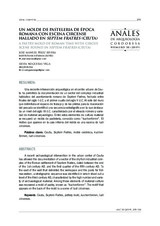Un molde de pastelería de época romana con escena circense hallado en Septem Fratres (Ceuta)
A pastry mold of roman time with circus scene found in Septem Fratres (Ceuta)
Autor
Pérez Rivera, José Manuel
Nogueras Vega, Silvia
Editor
Universidad de Córdoba, Área de ArqueologíaFecha
2019Materia
CeutaSeptem Fratres
Molde cerámica
Kuchenformen
Ludi circenses
Pottery mold
METS:
Mostrar el registro METSPREMIS:
Mostrar el registro PREMISMetadatos
Mostrar el registro completo del ítemResumen
Una reciente intervención arqueológica en el centro urbano de Ceuta ha permitido la documentación de un sector del complejo industrial haliéutico del asentamiento romano de Septem Fratres, fechado entre finales del siglo I d.C. y el primer cuarto del siglo V d.C. Al este del muro que delimitaba el espacio de trabajo y de las piletas para la maceración del pescado se identificó una secuencia estratigráfica en la que destacaba un nivel del siglo III d.C. caracterizado por el elevado número y variedad de material arqueológico. Entre estos elementos de cultura material se recuperó un molde de pastelería, conocido como “kuchenformn”. El motivo que aparece en la cara interna del molde es una escena de ludi circenses. A recent archaeological intervention in the urban center of Ceuta has allowed the documentation of a sector of the dry fish industrial complex of the Roman settlement of Septem Fratres, dated between the end of the 1st century AD. and the first quarter of the fifth century AD. To the east of the wall that delimited the workspace and the pools for fish maceration, a stratigraphic sequence was identified in which stood out a level of the third century AD, characterized by the high number and variety of archaeological material. Among these elements of material culture was recovered a mold of pastry, known as “kuchenformn”. The motif that appears on the back of the mold is a scene of ludi circenses.

